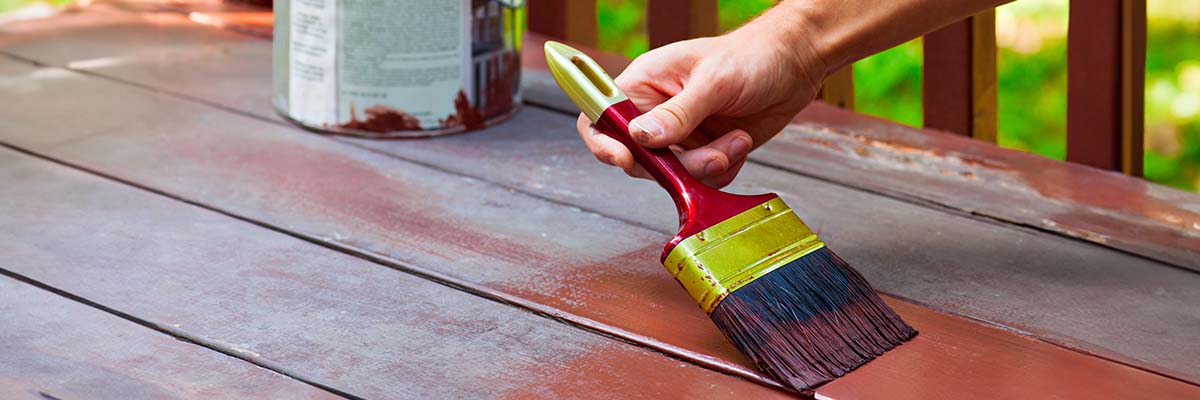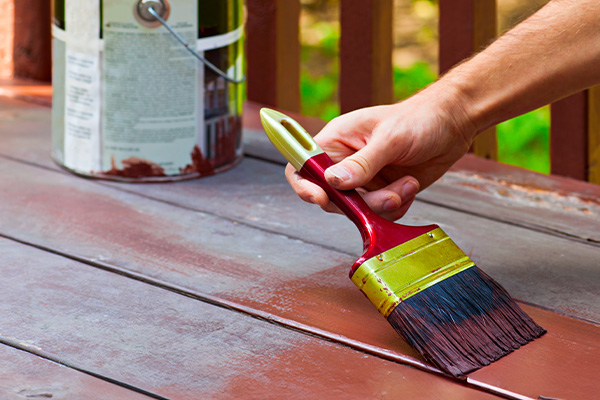

Painting Pressure Treated Wood Gives New Life to Lumber
Pressure treated wood is a great long-lasting material choice for outdoor projects like decks, porches, fences, and more. While it’s durable on its own, it can also be painted to give your project even more longevity, or to change the look of your outdoor space quickly. Here’s how to paint pressure treated wood the right way.
What is Pressure Treated Lumber?
Pressure treated wood starts as softwood like pine which then is chemically treated. The treatment involves forcing water or oil-based solutions and chemicals through the wood, which leaves the lumber more able to fight rot or decay, and to resist damage from termites and fungus.
Learn more about pressure treated wood and shop materials at McCoy’s.
Pressure treated wood is intended for outside use only. You can be sure you have the right type of treated lumber by reading the informational tag attached to the end of each piece at the lumber yard. The tag will indicate:
- If the lumber is above-ground or ground-contact rated,
- the type(s) of preservative(s) used on the wood (like MCA or CCA), and
- an indication on its rot-resistance level, known as the “retention level” (higher means greater rot resistance).
How to Know if Your Pressure Treated Wood is Ready to Paint
The keyword here is dry. You want the pressure treated wood to be extremely dry before you paint it. If it’s not, the paint will not last and may in fact peel or blister.
New pressure treated lumber is shipped “wet” because it’s saturated with the treatment materials. If you’re replacing old pieces of pressure treated lumber in an existing outdoor project with new ones, or building a new structure you want to paint or stain, you may need to wait weeks or even months for the treated wood to fully dry out. Testing the wood carefully to check its internal moisture content before you put brush to paint is key for a good result.
You can test pressure treated wood with a simple “water sprinkle” test. Drop a few drops of water on the wood you want to paint. If the water is absorbed within 10 minutes, then it’s dry enough. You can also use a device like a moisture meter to test the wood. Ideal dryness can vary depending on relative humidity and wood type, but generally, wood should read 12-15% or less before painting or staining. (Pressure treated wood leaves the factory with a moisture content between 45 to 90%, which is why you must let it dry several weeks or months before painting or staining!)
If your pressure treated wood fails the “water sprinkle” test, or you just had a thunderstorm blow through, don’t give up all hope! Certain treated lumber-like products that are kiln-dried can dry out rapidly. It will have a designation of “kiln-dried after treatment (KDAT)” on the lumber end tag. Keep testing until your wood signals it’s dry enough.
Should You Paint or Stain Pressure Treated Lumber?
Depending on the overall look you’re aiming for, staining pressure treated wood will give your project a more “natural” finish choice over painting. The additional benefits are that a wood stain can penetrate deeper into treated lumber, and the result will show off the beautiful wood grain, giving it a more natural aesthetic. If you’re after a more dramatic, opaque color change, then paint can be the right choice. Also true if your wood is especially old and needs more of a facelift.
You should note the exact type of pressure treated lumber used for your entire project space when you’re making your paint choices. If you plan to use different types of treated wood, check their compatibility with each paint and primer by reading the labels. Compare the manufacturer’s recommendations to your types of pressure treated wood.
What Type of Paint is Best for Pressure Treated Wood?
Built for longevity, pressure treated wood can last 20 or even 40 years in the right conditions. However, as the preserving chemicals fade and the wood ages, you may notice a color change in the wood, and want to make it more uniform with a paint or stain application. A stain or sealant application early on in your lumber’s life can also help preserve its original color.
For pressure treated wood, a water-based exterior latex paint and latex primer are the best choices. Oil-based paints will not adhere correctly and should be avoided for this type of project.
Materials needed for painting or staining pressure treated wood:
Cleaning/Prep:
- Nylon-bristle brush
- Mild cleaning solution (soapy water can work!)
- Two-part expoy wood filter (optional)
Painting:
- Paint brush(es)
- Paint roller with 3/8" nap
- Paint cleaner
- Dropcloths
- Exterior latex paint primer
- Water-based exterior latex paint
Steps to Paint Pressure Treated Lumber
Here are simple steps to take when painting treated lumber:
- Clean the wood. Remove debris from the area. Then thoroughly clean your pressure treated wood to remove dirt, mildew, and mold. A stiff nylon-bristle brush and a mild cleaner like soap and water can make quick work of this task.
- Fix damaged wood. If needed, first apply a two-part epoxy wood filler and then an epoxy resin to patch any small holes or damage. (If you need to replace whole treated wood boards, see the note above about fresh lumber drying times before painting.)
- Apply primer. Don’t skip the primer! Use a roller on large areas or paint brush to apply the primer.
- Apply paint. Once the primer has dried (about 30-60 minutes, depending on weather conditions), you should be ready to apply paint using a roller for large flat areas, and a brush for harder-to-reach ones. Once done with a first coat, wait until it is fully dry (anywhere from minutes to hours, depending on the type of paint and the conditions) and then apply a second coat.
Note: If the weather is especially humid, it could take longer for each step of primer or paint application to fully dry.
Ready to Get Started? Get Everything Delivered from McCoy’s
Not only can the project experts at McCoy’s help you pick out the right lumber or paint for your pressure treated wood project, they can help get it to your home or project site too! Ask a team member at your local store about our quick and convenient delivery services.
